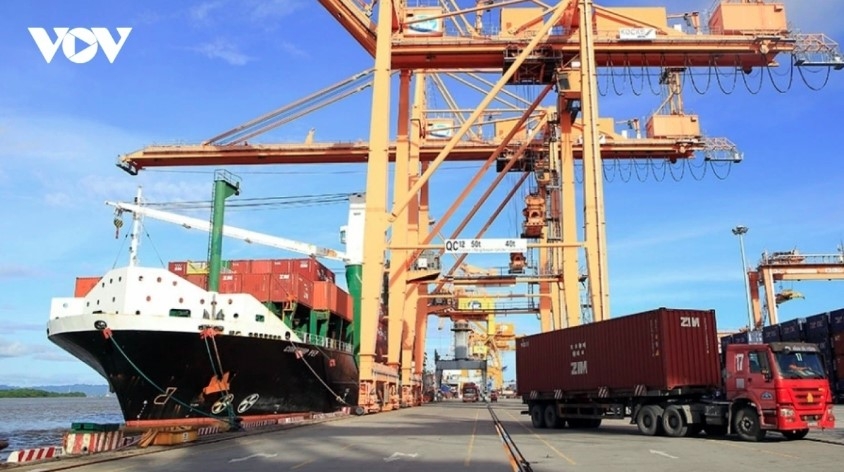Vietnam's exports navigate new challenges and opportunities in 2025
VOV.VN - Vietnam's exports will face a new cycle of fluctuations in 2025, with numerous uncertainties arising in the global market, especially due to new policies from the United States, according to economic experts.
Challenges in exports to the US
According to the General Statistics Office, Vietnam’s export turnover in 2024 soared by 14.3% year-on-year to US$405.5 billion, driven by growth across major export markets. Manufacturing remained the primary pillar, contributing nearly 85% of the total export value.
The 2025 Investment Strategy Report, published by VNDIRECT Securities Corporation, stated that Vietnam’s export turnover in 2024 rebounded by 14.3% from the previous year, thanks to the strong performance of machinery, electronic devices, and wood products. The US retained its position as Vietnam's largest export market, with machinery, electronics, and wood products leading the growth.
The report also noted that the US remains Vietnam’s largest export destination and a key contributor to the country’s trade surplus, reflecting the export sector’s reliance on the US economy. Any changes in the US's economic conditions or policies could significantly affect Vietnam's export outcomes. In particular, the new policies introduced by President Donald Trump are expected to continue influencing export turnover.
Export scenarios under US tariff policies
VNDIRECT outlined scenarios for Vietnam’s machinery and equipment exports—the largest category exported to the US—based on different tariff scenarios:
Negative scenario: A 60% tariff on Chinese goods combined with universal tariffs of 10–20% and additional tariffs on Vietnam; Baseline scenario: A 60% tariff on Chinese goods and universal tariffs of 10–20%; Positive scenario: A 60% tariff on Chinese goods without universal tariffs.
In the short term, heightened tariffs may prompt US businesses to accelerate imports and stockpile goods from Vietnam before the new policies take effect. Additionally, exporters could benefit from a stronger US dollar, partially offsetting the impact of tariffs.
In the long term, higher tariffs on Chinese imports could incentivize US companies to shift supply chains to Vietnam, enabling Vietnamese exporters to expand their market share. However, weakened consumer demand could lead to higher import prices due to new tariffs, potentially driving inflation and reducing US consumer spending, which would negatively impact demand for imported goods.
At a Q4 2024 press briefing held by the Ministry of Industry and Trade Tran Thanh Hai Deputy Director of the Import-Export Department, affirmed that the US remains Vietnam’s largest export market. In 2024, Vietnam ranked as the US's 8th largest trading partner, accounting for 4.13% of total export turnover to the US.
Hai noted that under President Donald Trump’s administration, the US aims to reduce its trade deficit, boost domestic production, and attract investment, while employing tariffs as a traditional tool. In the past, US tariffs had limited impact on Vietnamese exports. However, heading into 2025, the Ministry of Industry and Trade has outlined two scenarios:
Optimistic scenario: The US maintains its current tariff policies on Vietnamese goods. This, coupled with supply chain shifts, could lead to increased investment and export growth.
Pessimistic scenario: Stricter tariff policies may impact the global economy, affecting Vietnam’s exports. Challenges in China, the US's major trading partner, could also exert pressure on Vietnam. In this case, the ministry will propose measures to the government to support businesses in diversifying markets.
Outlook for major export items
According to VNDIRECT, Vietnam’s key export products are expected to experience significant fluctuations in 2025.
Textiles and garments: Export turnover surged by 33% year-on-year to US$44 billion in 2024, meeting the annual target. Exports became less reliant on the US market as Vietnamese manufacturers expanded globally while maintaining stable orders from the US. Despite challenges such as inflation dampening consumer demand and high clothing inventory levels, many manufacturers secured enough orders for Q1 2025 and received early bookings for Q2. Imports of cotton and yarn surged in late 2024, up by 14% and 18.2% year-on-year, respectively, reflecting ample raw material supplies to meet rising demand.
Pangasius (catfish): Over the past 11 months of 2024, pangasius exports grew by 10% year-on-year to US$1.8 billion. The US led growth due to competitive pricing and limited supply of tilapia, a direct substitute.
In 2025, the US is expected to remain a key market, driven by low pangasius inventory, increasing seafood demand, and rising tilapia prices due to supply constraints and higher tariffs.
Raw fish and fingerling prices dropped by 1.3% and 13.7%, respectively, in 2024, despite a slight price increase in December. Feed prices remained stable and low, supporting gross margins and profitability for Vietnamese exporters.
In addition, a stronger US dollar under President Trump’s administration may offset the impact of higher tariffs, supporting both export volume and revenue.
Dr. Le Quoc Phuong, former Deputy Director of the Trade and Industry Information Center under the Ministry of Industry and Trade, projected that export growth in 2025 could surpass 2024 levels due to recovering global market demand. While new US policies may pose challenges, the US is expected to remain Vietnam's largest export market.
Nguyen Anh Son, Director of the Import-Export Department at the Ministry of Industry and Trade, added that 2025 will likely bring unpredictable global trade fluctuations. The ministry is actively facilitating conditions for local businesses and advising on finalizing legal documents to simplify participation in import-export activities.




